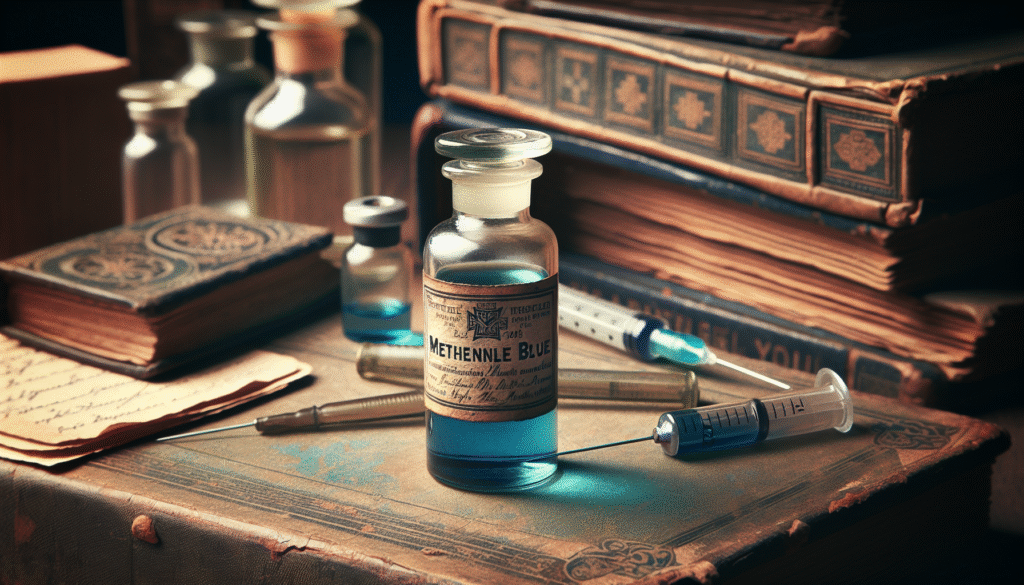
What do you know about the fascinating journey of methylene blue in the realm of medicine? Its historical use has spanned over a century, demonstrating its remarkable versatility and significance in various medical applications. As you delve into its past, you’ll find a wealth of scientific insights and clinical practices that showcase how one compound has evolved in utility and understanding.
Introduction to Methylene Blue
Methylene blue, a synthetic dye, has a rich history that intertwines with medical advancements. Initially introduced in the late 19th century, it served multiple purposes before gaining recognition for its therapeutic benefits. This section will provide a brief overview of its origins and its transition into the medical field.
Methylene blue was first synthesized in 1876 and originally used as a dye in textiles. Its vivid blue color caught the attention of researchers who subsequently investigated its potential medical properties. Understanding its multifaceted history is crucial in appreciating its current applications.
Early Medical Applications
Treatment of Malaria
In the late 1800s, researchers discovered that methylene blue was effective in treating malaria. It operated by inhibiting the growth of the parasite responsible for the disease. During a time when antimalarial drugs were limited, this discovery was groundbreaking, providing relief to countless individuals suffering from malaria.
The compound was utilized primarily in the form of an intravenous solution. However, its use waned with the discovery of more effective treatments. Despite this, methylene blue remains a significant historical reference point in the fight against malaria.
Antidote for Cyanide Poisoning
Another critical application was its discovery as an antidote for cyanide poisoning. During the early 20th century, methylene blue garnered attention due to its ability to convert methemoglobin back to hemoglobin, effectively counteracting the effects of cyanide toxicity. This property made methylene blue a valuable asset in emergency medicine.
Cyanide poisoning can occur from exposure to certain chemicals or during combustion processes. The swift administration of methylene blue can be lifesaving, illustrating its vital role in acute care settings.

Mechanism of Action
Methemoglobinemia Treatment
Methylene blue’s most well-known mechanism lies in its ability to treat methemoglobinemia, a condition in which hemoglobin is transformed into methemoglobin, impairing the blood’s oxygen-carrying capacity. This condition can arise from genetic factors, medications, or exposure to certain chemicals.
The mechanism involves electron transfer; methylene blue is reduced to leucomethylene blue, which then donates electrons to methemoglobin, converting it back to functional hemoglobin. Understanding this biochemical process is fundamental to utilizing methylene blue effectively in clinical settings.
Antimicrobial Properties
In addition to its hematological applications, methylene blue exhibits antimicrobial properties. Research has demonstrated its efficacy against a range of pathogens, including bacteria, viruses, and fungi. This dual action enables its use in treating various infections, further solidifying its importance in medicine.
The precise mechanisms by which methylene blue exerts its antimicrobial effects continue to be a subject of research. Its ability to penetrate cell membranes and generate reactive oxygen species contributes to its potency as an antimicrobial agent.
Expanding Therapeutic Uses
Recent Pharmacological Advances
As science and medicine evolved, researchers revisited methylene blue, uncovering new therapeutic uses. Its role in treating conditions such as Alzheimer’s disease, septic shock, and certain urinary tract infections has garnered attention in contemporary medicine.
Recent studies suggest that methylene blue may enhance mitochondrial function, potentially offering benefits in neurodegenerative disorders like Alzheimer’s. Increasing evidence supports its neuroprotective properties, indicating that it could play a role in mitigating cognitive decline associated with aging.
Methylene Blue in Psychiatry
An area of growing research involves the use of methylene blue in psychiatric applications. Some studies have indicated its potential as an adjunct treatment for major depressive disorder and bipolar disorder. Initial findings suggest that its capacity to modulate mitochondrial function and improve cellular energy metabolism may contribute to mood stabilization.
The implications are profound; integrating methylene blue into psychiatric treatment regimens could provide new avenues for patient care. However, further clinical trials are necessary to solidify its efficacy and safety in these contexts.

Current Applications and Research
Methylene Blue in Cancer Therapy
In recent years, methylene blue has emerged as a candidate for cancer therapy. The compound’s ability to promote apoptosis in cancer cells while preserving normal cells is an area of active research. By inducing cell death selectively, methylene blue presents a promising strategy for targeting cancerous tissues.
Table 1 below summarizes the applications of methylene blue in various cancer types:
| Cancer Type | Mechanism of Action | Research Findings |
|---|---|---|
| Lung Cancer | Induces apoptosis | Early-stage studies showing efficacy |
| Breast Cancer | Inhibits cell proliferation | Significant reductions in tumor size |
| Colorectal Cancer | Promotes cellular death | Enhanced survival rates in models |
Research in this area is still in its infancy, but preliminary findings indicate that methylene blue could become a valuable asset in oncology.
Veterinary Medicine
Surprisingly, methylene blue has found utility not only in human medicine but also in veterinary practices. It is often used to treat methemoglobinemia in animals and has shown promise in other conditions affecting various species.
Veterinarians appreciate methylene blue’s rapid action and efficacy. Understanding the similarities and differences in human and veterinary applications can highlight its versatility as a medical compound.
Safety and Side Effects
Adverse Reactions
While methylene blue is generally regarded as safe when used appropriately, it is not without potential side effects. Some individuals may experience allergic reactions, characterized by itching, rashes, or more severe responses.
Other common side effects include:
- Urinary discoloration: A benign effect where urine may turn blue or green.
- Tissue staining: Localized staining at injection sites.
- Serotonin syndrome: A potential complication when combined with other serotonergic medications, especially in psychiatric settings.
Awareness of these side effects is crucial for healthcare providers to mitigate risks during treatment.
Contraindications
Certain populations should exercise caution or avoid methylene blue altogether. For example, individuals with G6PD deficiency risk hemolytic anemia when exposed to methylene blue. Additionally, pregnant and breastfeeding individuals should consult with healthcare providers before use, as safety data in these populations are limited.
A detailed understanding of contraindications can ensure that you make informed decisions regarding treatment protocols.

Conclusion
The historical journey of methylene blue reflects its dynamic relationship with medicine. From its initial use as a textile dye to its current applications in diverse medical fields, it has proven to be invaluable. Its mechanisms of action, expanding therapeutic uses, and ongoing research illustrate that this compound remains worthy of attention.
As new studies continue to emerge, methylene blue’s potential in treating various ailments may grow even further, reshaping the landscape of medical treatments available to you and your peers. Not only does it highlight the importance of investigating older compounds for contemporary uses, but it also reinforces the notion that innovation can arise from reassessment and rediscovery.